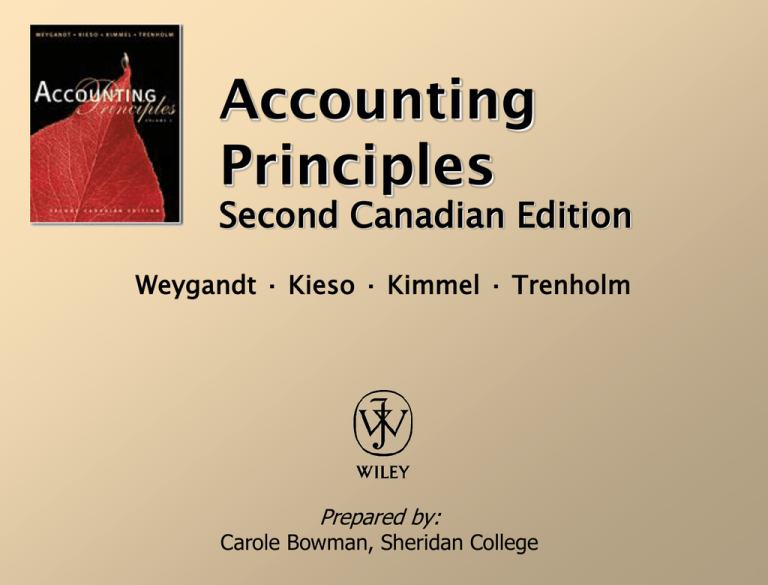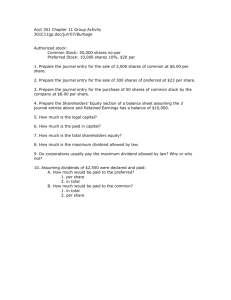
Accounting
Principles
Second Canadian Edition
Weygandt · Kieso · Kimmel · Trenholm
Prepared by:
Carole Bowman, Sheridan College
CHAPTER
14
CORPORATIONS:
ORGANIZATION AND SHARE
CAPITAL TRANSACTIONS
CORPORATE FORM OF
ORGANIZATION
A corporation is a legal entity created by
law that is separate and distinct from its
owners
CLASSIFICATION OF
CORPORATIONS
A corporation’s purpose may be to earn
a profit, or it may be organized as nonprofit.
Classification by ownership distinguishes
between publicly-held corporations and
privately-held corporations.
CHARACTERISTICS
Separate legal existence
Limited liability of shareholders
Transferable ownership rights
Ability to acquire capital
Continuous life
Corporation management
Government regulations
Additional taxes
ILLUSTRATION 14-1
ADVANTAGES AND DISADVANTAGES
OF A CORPORATION
Advantages
Corporate management professional managers
Separate legal existence
Limited liability of
shareholders
Deferred or reduced income
taxes
Transferable ownership rights
Ability to acquire capital
Continuous life
Disadvantages
Corporation management ownership separated from
management
Increased costs and complexity
to adhere to government
regulation
Potential for additional income
taxes
ORGANIZATION COSTS
Costs incurred in forming a corporation are
called organization costs.
These costs include fees to underwriters,
legal fees, incorporation fees, and
promotional expenditures.
Organization costs are normally expensed in
the year the organization cost is incurred.
SHAREHOLDER RIGHTS
To raise capital, the corporation sells
shares
If only one class of shares-common
shares
Ownership rights specified in articles of
incorporation or by-laws
– Voting…owners
SHARE TERMINOLOGY
Authorized shares – maximum amount
of shares a corporation is allowed to sell
as authorized by corporate charter
Issued shares – number of shares sold
SHARE ISSUE CONSIDERATION
How many shares should be authorized for
sale?
How should the shares be issued?
At what price should the shares be issued?
What value should be assigned to the
shares?
STOCK MARKET PRICE
Shares of publicly held companies are
traded on organized exchanges at dollar
prices per share established by the
interaction between buyers and sellers
STATED AND PAR SHARE VALUES
Stated value – assigned value to no-par
value shares
Par value – assigned legal capital value
Must retain legal capital.
Stated and par values have NO
relationship to market value
NO PAR SHARE VALUES
No assigned legal capital value
Legal capital equals issue price
(proceeds)
Must retain legal capital.
No-par value has NO
relationship to market value once issued.
ILLUSTRATION 14-5
RELATIONSHIP OF PAR, NO PAR AND
STATED VALUE SHARES TO LEGAL
CAPITAL
Shares
Legal Capital per Share
Par value
No par value
Par value
Entire proceeds
Stated value
Stated value
ISSUING NO PAR VALUE
COMMON SHARES FOR CASH
Shares are most commonly issued for cash. When
no par value common shares are issued, the entire
proceeds from the issue becomes legal capital.
Account Titles and Explanation
Cash
Common Shares
To record issue of 1,000 shares.
Debit
Credit
1,000
1,000
CORPORATE CAPITAL
Shareholders’ equity (owner’s equity)
The shareholders’ equity section of a
corporation’s balance sheet consists of:
– Contributed capital
• Share capital
• Additional contributed capital
– Retained earnings
ILLUSTRATION 14-6
SHAREHOLDERS’ EQUITY SECTION
Shareholders’ equity
Contributed capital
Common shares, 100,000 no par value
shares authorized, 50,000 issued
Retained earnings
Total shareholders’ equity
$800,000
130,000
$930,000
ISSUING STATED VALUE
COMMON SHARES FOR CASH
When common shares have a stated value, the stated
value is credited to Common Shares. When the selling
price exceeds the stated value, the excess is credited to
Contributed Capital in Excess of Stated Value.
Account Titles and Explanation
Cash
Common Shares
Contributed Capital in Excess of Stated Value
To record issue of 1,000 shares.
Debit
Credit
5,000
1,000
4,000
SHAREHOLDERS’ EQUITY CONTRIBUTED CAPITAL IN EXCESS
OF STATED VALUE
Shareholders’ equity
Contributed capital
Common shares, 10,000 shares of $1 stated value authorized,
2,000 shares issued
Contributed capital in excess of stated value
Total contributed capital
Retained earnings
Total shareholders’ equity
$ 2,000
4,000
6,000
27,000
$33,000
ISSUING COMMON SHARES FOR
SERVICES OR NON-CASH ASSETS
Shares may be issued for services, such as
compensation to lawyers, or for non-cash assets,
such as land.
When common shares are issued for services or
non-cash assets, cost is either the fair market
value of the consideration given up or the
consideration received, whichever is more clearly
determinable.
REACQUIRED SHARES
Reacquired shares are a corporation’s own
shares that have been issued, fully paid for,
and then reacquired by the corporation.
Reacquired shares are generally retired
and cancelled.
In certain restricted circumstances, these
shares are not retired, but are held as
treasury shares for later reissue.
REACQUISITION OF SHARES
Why would a company choose to
reacquire its shares?
– Reduce quantity/raise share price
– Increase EPS
– If authorized share limit reached, may need
additional shares for use in bonus or
compensation plans or acquisitions
PREFERRED SHARES
Preferred shares have priority over common
shares with regards to:
1. Dividends and
2. Assets in the event of liquidation
Preferred shareholders usually do not have
voting rights
Preferred shares are shown first in the share
capital section of shareholders' equity
PREFERRED SHARE
PREFERENCES
Liquidation preference
Cumulative (dividends in arrears)
Convertible (book value)
Redeemable/callable (company option)
Retractable (shareholder option)
DIVIDEND PREFERENCES
CUMULATIVE DIVIDEND
A cumulative dividend requires that preferred
shareholders be paid both current and prior year
dividends before common shareholders receive any
dividends.
Preferred dividends not declared in a given period are
called dividends in arrears.
Dividends in arrears are not considered a liability, but
the amount of the dividends in arrears should be
disclosed in the notes to the financial statements.
CONVERTIBLE PREFERRED
SHARES
Convertible preferred shares allow the exchange
of preferred shares into common shares at a
specified ratio.
This kind of share is purchased by investors who
want the greater security of a preferred share, but
who also desire the added option of conversion.
In recording the conversion, the book value of the
preferred shares is used.
The conversion of preferred shares does not result
in either gain or loss to the corporation.
The market value of the shares is not considered.
REDEEMABLE PREFERRED
Redeemable (callable) preferred shares grant the issuing
corporation the right to purchase the shares from
shareholders at specified future dates and prices.
This call feature allows some flexibility to a corporation
by enabling it to eliminate this type of equity when
it is advantageous to do so.
While convertible shares are for the
benefit of the shareholder, redeemable
shares are for the benefit of the
corporation.
RETRACTABLE PREFERRED
Retractable preferred shares are similar to
redeemable preferred shares except that the
shareholder can redeem shares at their option instead
of the corporation’s.
Retractable preferred shares and debt have many
similarities.
Both offer a rate of return to the investor, and with the
redemption of the shares they both offer a repayment
of the principal investment.
Retractable preferred shares are presented in the
liability section of the balance sheet rather than in the
equity section because it has more of the features of
debt than equity.
REMINDERSTATEMENT PRESENTATION OF
SHAREHOLDERS’ EQUITY
In the shareholders’ equity section of the balance
sheet, contributed capital and retained earnings
are reported and the specific sources of
contributed capital are identified.
Within contributed capital, two classifications are
recognized:
1. Share capital
2. Additional contributed capital
ILLUSTRATION 14-10
SHAREHOLDERS’ EQUITY
PRESENTATION
ZABOSCHUK INC.
Partial Balance Sheet
Shareholders’ equity
Contributed capital
Share capital
$9 preferred shares, no-par value,
cumulative, 10,000 shares authorized,
6,000 shares issued
$ 770,000
Common shares, $5 stated value, unlimited shares
authorized, 400,000 shares issued
2,000,000
Total share capital
2,770,000
Additional contributed capital
Contributed capital in excess of stated value - common shares
860,000
Total contributed capital
3,630,000
Retained earnings
1,058,000
Total shareholders’ equity
$4,688,000
RETURN ON EQUITY
Return on equity (or return on
investment) is considered to be the most
important measure of a firm’s
profitability and efficiency.
Evaluates how many dollars were earned
for each dollar invested by the owners.
Net Income
Average
Shareholders
Equity
=
Return on
Equity
BOOK VALUE PER SHARE
Book value per share represents the equity a
common shareholder has in the net assets of
the corporation from owning one share.
The formula for calculating book value per
share when a corporation has only one class of
shares is:
Total
Shareholders’
Equity
Number of
Common
Shares
=
Book Value
per Share
CALCULATION OF BOOK VALUE
WITH PREFERRED SHARES
When a company has both preferred and common
shares, the calculation of book value is more complex.
Steps required are:
1. Calculate the preferred shareholders’ equity (the sum of
redemption price of preferred shares plus any
cumulative dividends in arrears).
2. Determine the common shareholders’ equity (total
shareholders’ equity less preferred shareholders’ equity).
3. Divide common shareholders’ equity by the number of
common shares to determine book value per share.
BOOK VALUE VS. MARKET VALUE
Book value per share seldom equals market value.
Book value is based on historical costs; market
value reflects the subjective judgement of
thousands of shareholders and prospective
investors about the company’s potential for future
earnings and dividends.
Market value per share may exceed book value per
share, but that fact does not necessarily mean that
the shares are overpriced.
COPYRIGHT
Copyright © 2002 John Wiley & Sons Canada, Ltd. All rights reserved.
Reproduction or translation of this work beyond that permitted by
CANCOPY (Canadian Reprography Collective) is unlawful. Request for
further information should be addressed to the Permissions Department,
John Wiley & Sons Canada, Ltd. The purchaser may make back-up copies
for his / her own use only and not for distribution or resale. The author and
the publisher assume no responsibility for errors, omissions, or damages,
caused by the use of these programs or from the use of the information
contained herein.







